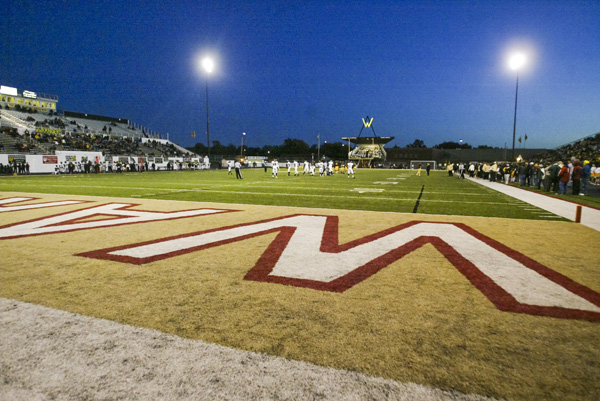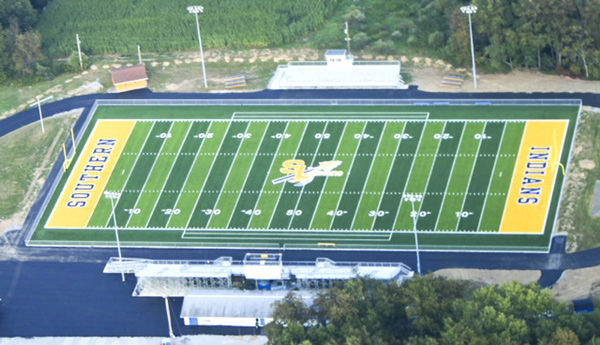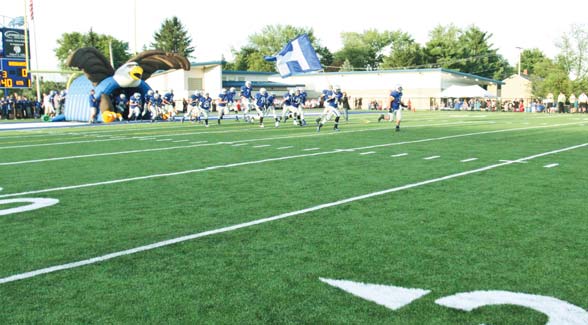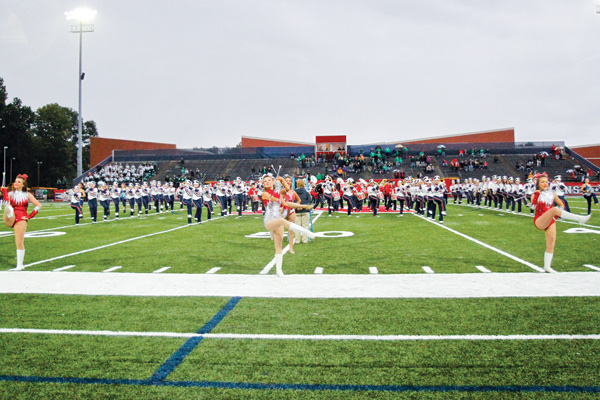Turf time: More Valley schools investing in synthetic surfaces


Southern Local’s Wigwam Stadium in Salineville

Hubbard’s Memorial Stadium

Bo Rein Stadium in Niles

Warren’s Mollenkopf Stadium
By Steve Ruman
When Tim Parry helped form the REIN Committee in 2007, his vision to equip Niles’ Bo Rein Stadium with synthetic turf through private donations was viewed by many as a luxury rather than a necessity.
Parry knew better.
“Because of the building of our new high school, we were losing a field that was used for practices and for most of our lower-level games,” Parry said. “Our groundskeepers have always done a great job of maintaining the field at Bo Rein Stadium. However, when you schedule nearly 60 events on one field during a two-month period, eventually something is going to give.”
Much to his dismay, Parry’s forward thinking proved accurate in October of 2011 when Niles had to cancel several home events, and move its final varsity home football game of the year to a neutral location.
“That night, we not only took a financial hit, but our students lost out, and as a community our image took a hit,” Parry said.
Spurred on by the cancellations, the REIN Committee (Renovating Excellence In Niles), community leaders, local businesses and the school district joined forces to secure enough funds to move forward with the project. On Friday, Niles hosted its first game on synthetic turf.
“What an exciting atmosphere and a thrill to christen the new field,” Niles coach Brian Shaner said after his Red Dragons defeated West Branch. “With the excitement of this entire city, we had to block out the emotion and focus on the importance of our opponent. It wasn’t easy, because everywhere you went people talked about the new field.”
Niles was one of three area schools to install turf this summer. Southern Local and Hubbard also did away with grass — and the headaches that can go along with maintaining a natural surface.
Of the 44 football-playing schools in Columbiana, Mahoning and Trumbull Counties, 13 — or 30 percent — now play their home games on turf. This includes Cardinal Mooney and Ursuline, which play at Youngstown State, and Youngstown Christian and Warren JFK, which rent out other high school facilities.
“People used to argue that we couldn’t afford turf,” said Southern superintendent John Wilson. “It really got to a point to where we couldn’t afford not to get turf.
“With our recent water and drainage issues, and with the overall cost to maintain a grass field, going to synthetic turf was really in the best financial interest of our school district. On top of that, the excitement it brought, and the usage it will give us made this an easy choice.”
Parry estimated that the Niles school district spent approximately $35,000 a year to maintain its grass field, a figure confirmed by a number of area athletic directors.
The turf installation at Niles cost $526,000. Through private donations, the REIN Committee paid for $270,000 of the work, while the school district picked up the remaining costs.
“The district basically paid the cost of what it would have paid to maintain grass over a 10-year period,” Parry said. “And with it, we get virtually unlimited use and more opportunities to make revenue because of it.”
Turf is generally warranted by its supplier for eight years. Most synthetic fields in the northeastern and midwestern parts of the United States have a lifespan of about 10-12 years. Replacing worn turf will cost roughly $350,000.
“Again, when you look at the cost of replacing and how long it will last, you’re looking at the same price of maintaining a grass field,” Parry said.
Bob Thomas is the president of ProGrass, the company which installed the turf at Bo Rein Stadium. Thomas is a 1975 Liberty High graduate. He later played at Hiram, where he also coached and served as the school’s athletic director.
Thomas noted that there are approximately 8,000 synthetic turf fields in the United States, including baseball and soccer-only fields. He said the current-day material used for turf is a far cry from what it was during the early days of “artificial grass.”
“The old knock on turf was its plastic look, and its carpet-like feel,” Thomas said. “Today’s synthetic turf truly has a grass-like look to it. In terms of its makeup, it is more comfortable to play on than grass. In terms of injuries, it is proven to be safer.”
Thomas also noted that with turf, a field which in the past was limited in its use immediately offers unlimited possibilities.
“Once turf is installed at a high school stadium, it’s not viewed as just a football field any longer, it’s viewed as a community venue,” Thomas said. “Nearly every school sports program can benefit in some way, as can the band. Beyond school events, it can be used for community events.”
Like many schools, Hubbard uses its high school football field for boys and girls soccer games, and for all lower-level football games. Hubbard athletic director Chuck Montgomery noted that in 2011 heavy rains coinciding with excessive field use created a nightmarish September.
“By the third week, things were a total mess,” Montgomery said. “At that point, you have to sometimes begin picking and choosing who can and can’t use the field, and that’s not fair to all students.
“Now, our field will be used by everyone from the band to the baseball and softball teams to the Little Eagles. It truly will serve the entire community.
Wilson echoed the comments made by Montgomery, noting that his district “will continue to find new uses for our turf as time goes on.” He said that in addition to its practicality, the turf has boosted the spirits of the community.
“I look out the window and see the elementary school children running around on it during gym class, and they are having a ball,” Wilson said. “When we hosted our first varsity game on turf, the look on the faces of so many fans displayed a sense of deep pride.”
In Niles, the money put forth by the REIN Committee was made possible in large part due to a $200,000 donation from the Cafaro Foundation. As a result, “Eastwood Mall Field” is prominently displayed on each sideline of the newly surfaced field at Bo Rein Stadium.
“The Cafaros didn’t ask that we name the field in their honor, but it was our way of paying forward,” Parry said. “Anyone willing to make such a big effort to help out our cause deserves to be recognized.”
Other prominent donors are recognized on the band shell, on fencing and in other areas throughout the stadium. The idea of advertising rights in exchange for monetary donations is a trend which many high school athletic programs can benefit from, according to Warren City Schools superintendent Paul Trina.
“In this day and age, all school districts have to look at alternative ways of raising revenue,” Trina said. “We are always very open to those who want to back our programs, and why not show your appreciation inside the stadium?”
Installed in the summer of 2005, Warren has the oldest synthetic turf of all area high schools. Though its eight-year warranty is up, Trina noted the field remains in “really great shape,” and he expects to get four or five more years of use before the surface must be replaced.
“School districts just need to plan accordingly and be prudent in their spending,” Trina said. “We’ve generated a lot of revenue over the years because of the turf. If we put a little of that away each year, we won’t be caught off guard when the turf needs replaced.
“It has easily paid for itself. I think you will find that all districts who install turf will tell you likewise. Those who got turf this year, they are going to like the results.”
In addition to serving Warren City School students, the district rents Mollenkopf Stadium to neighboring Warren JFK. It also regularly hosts playoff games.
“Let’s put it this way,” Trina said. “When the rains used to come, I cringed. Sometimes we had to make some very tough decisions on who could and couldn’t use the field. Today, regardless of weather, I just have to manage the hours.”
“Today, I see rain and I truly feel for other ADs, because I know the headaches they may be experiencing. It can be very problematic, but thankfully it is one problem we were able to eliminate.”
 43
43










Subscribe Today
Sign up for our email newsletter to receive daily news.
Want more? Click here to subscribe to either the Print or Digital Editions.
AP News